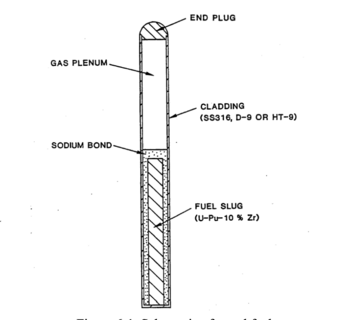Integral Fast Reactor

Choice of Fuel and Coolant
The IFR has a unique design for its fuel rods, which allows larger burnup of the fuel, and provides inherent safety if the rod ever gets too hot. The fuel slug is loose in the cladding, and there is space above the fuel to contain gaseous fission products released as the fuel is consumed. See Figure 1. In standard fuel rods, the cladding must be tight around the ceramic fuel pellets to ensure adequate thermal conductivity. This limits the lifetime of the rods, because the fuel swells and the cladding cracks as the gaseous fission products accumulate. The loose fit in the IFR rods is possible, because the gap is filled with highly conductive liquid sodium. Pure metallic fuel can be used, instead of oxides, because the sodium doesn't corrode the fuel or the cladding. If the fuel gets too hot, it melts and expands into the gas plenum shutting down the fission reaction.
Notes and References
- ↑ Fig.6.1 in PLENTIFUL ENERGY The Story of the Integral Fast Reactor, CHARLES E. TILL and YOON IL CHANG, 2011.